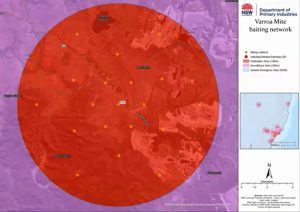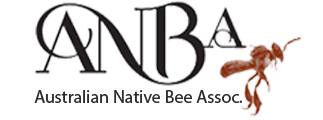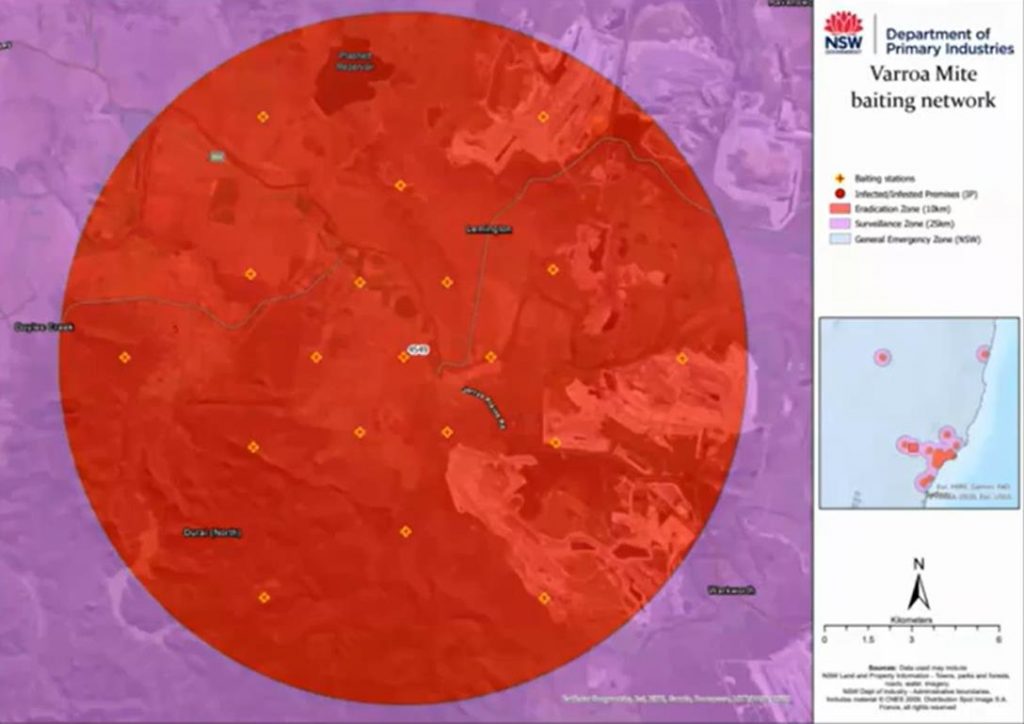ANBA recommends that keepers of stingless bees move their hives out of red zones soon
The Varroa mite eradication program is close to completing the euthanasia of all managed honey bee hives from the red zones. Next comes the eradication of feral honey bee colonies by a baiting program using an insecticide called fipronil.

Fipronil bait stations will be located and operated by NSW DPI within the 10-kilometre zone around each of the premises where Varroa mite was detected (the Varroa mite red eradication emergency zone). The fipronil bait stations are designed to exclude other animals and insects. While the fipronil bait stations are in active use, the baited area will be supervised by trained staff and the fipronil will be removed from bait stations overnight.
A trial program at Jerrys Plains appears to have succeeded in attracting and killing honey bee colonies. The next round of bait stations to be deployed are in the Nana Glen area, on the NSW mid north Coast. These bait stations will be operational from late October for approximately 6 months.
If the baiting program is a success, it will result in dead feral honey bee hives scattered throughout the red eradication zone. The insecticide in the dead colonies re-mains active for at least 26 months. We are not aware of any assessment of the risks to non-target organisms. Native stingless bee colonies may be attracted to the honey or other resources in the dead feral bee colonies, collect the resource, transport back to their nest, and poison their own colonies.
Although this risk would seem to be low, we recommend that meliponists play it safe and remove their hives. Native bees can be moved anytime without a permit.
If you are aware of native stingless bee colonies in natural locations within the red zones, please keep an eye on them and report any suspected poisoning, by phoning the DPI Pest Hotline 1800 084 881.
NSW DPI will regularly update the Australian Native Bee Association on the progress of baiting, as the response continues. We will relay advice to our members as it becomes available.
Get more information
Read FAQs on the NSW DPI Varroa mite website. Varroa mite emergency response (nsw.gov.au)
Listen to this if you want to know more about the insecticide (Fipronil) baiting program. Starts at 24.40 minutes. Youtube link
Is your hive in a red zone?
• Go to this website: Varroa mite emergency response (nsw.gov.au)
• Scroll down to the interactive Varroa mite emergency zone map.
• Enter your address into the search field.
• The map will locate your address and its placement in red, purple or blue zone.
How to move your hive of native stingless bees
Tips for transporting your hive
• Pack the hive at night when all bees are inside.
• Close all entrances to stop the bees leaving the hive. Use something that can breathe, such as a piece of material, gauze or fly screen. Push the piece of material into the en-trance loosely. Make sure all holes are plugged.
• For extra security, pack the hive into a cardboard carton.
• KEEP THE HIVE COOL. Put your car airconditioning on a low temperature. Do not leave the hive in a parked car. Take it with you and leave it in a cool, shady place. Treat the hive like you would treat your pet dog.
• Be careful with hives that are very full. Full hives have little air space inside and so are more susceptible to lack of oxygen than a hive that has a large volume of air space.
• Move you hive at least one kilometre, to prevent forgers returning to the old position.
• After moving a hive to a new position, remove the plugs. Bees should immediately emerge (if it is daylight and above 18°C). They will do a backwards hovering orientation flight to learn their new position.
Recommendations for positioning native bee hives
• You should choose the best position for your hive before releasing your bees for the first time; you don’t want to have to move your hive more often than necessary.
• Choose a suitable microclimate, that will be comfortable 24 hours a day, 365 days a year.
• On an urban house block, a covered outdoor area is usually a safe bet to position a hive. A position that receives morning sun in winter is optimal. Afternoon sun can cook a hive in summer, so avoid exposed western positions.
• Consider moving your hives to a cooler spot in summer and sunnier position in winter. For example, step your hive into the shade of a tree in summer and then out into the sun in winter.
Recommendations for mounting native bee hives
• Extend the life of your hive by protecting it from threats from below, particularly termites and damp.
• If outside, cover you hive with an overhanging roof to protect from sun and rain.
How is the ANBA responding?
ANBA Varroa eradication committee
ANBA has established a subcommittee, chaired by Dr Anne Dollin, to manage our response to the Varroa eradication, with the aim of helping at-risk stingless beekeepers to save their hives.
A primary aim is to help affected hive owners who do not have a safe location outside the Red Zones to place their hives. The ANBA plans to help these owners by fostering the hives on suitable properties and monitoring the welfare of these hives throughout the period that the Red Zones are unsafe.
If you are interested in joining the subcommittee or helping out in other ways, please contact the ANBA secretary, tim.heard@anba.org.au.
How is the research community responding?
Varroa & Bee Researcher Consortium
Varroa’s arrival in Australia, if not eradicated, poses a wide range of challenges to pollination, and raises many urgent research questions. Despite Varroa’s spread worldwide, how it affects honey bee populations and their interactions with native bees remains poorly understood. For instance, how does Varroa reshape competition between pollinators and reshape pollination networks? What might be the effect of viruses spread by Varroa that make their way into native bee populations? A large reason these questions remain unanswered is that pre-invasion data are missing in the rest of the world, where Varroa’s arrival was a surprise. In Australia, we can take advantage of hindsight and collect missing data to answer these questions and inform the actions we need to take in the future.
To outline research directions and coordinate efforts, a workshop was held at Australian National University’s Kioloa campus and attended by researchers from throughout Australia, as well as with Varroa experts from Europe and the US who joined via teleconference. The workshop outlined the immediate need to characterise feral bee population dynamics, including the plants they pollinate, what viruses course through them, and what native bee species live nearby. We will be working on establishing a nation-wide monitoring network, focused on trapping honey bee swarms, and surveying native bees. If you are interested in hosting swarm traps, please contact Prof. Sasha Mikheyev alexander.mikheyev@anu.edu.au.

